Since I started teaching myself how to bake breads, it just amazes me each and every time, that you can go from a lumpy, gloppy, mass of very few ingredients to a beautiful, crusty, golden loaf of delicious bread. One huge favorite of mine is the trusty ciabatta.
Ciabatta is a relatively modern Italian bread, first developed in the 1980s as a response to the French baguette, it is perfect for sandwiches, dipping in olive oil – or enjoying on its own. The high hydration dough and long fermentation gives it its signature holes and deep flavor, and it is a great home-baking project.
Why You’ll Love This Recipe:
- Authentic Italian Flavor: A traditional ciabatta, this recipe creates a beautifully rustic loaf with a crisp crust and airy interior.
- Perfect for Sandwiches & Dipping: The open crumb structure makes it great for panini, bruschetta, or simply dipping in olive oil.
- Simple Ingredients, Big Flavor: With just a handful of pantry staples, long fermentation develops deep, rich flavor.
- No Kneading Required: Stretch-and-fold technique replaces traditional kneading, which makes it approachable for beginners.
- Flexible Fermentation: The dough can be refrigerated for up to four days, allowing you to bake fresh bread when it suits your schedule.
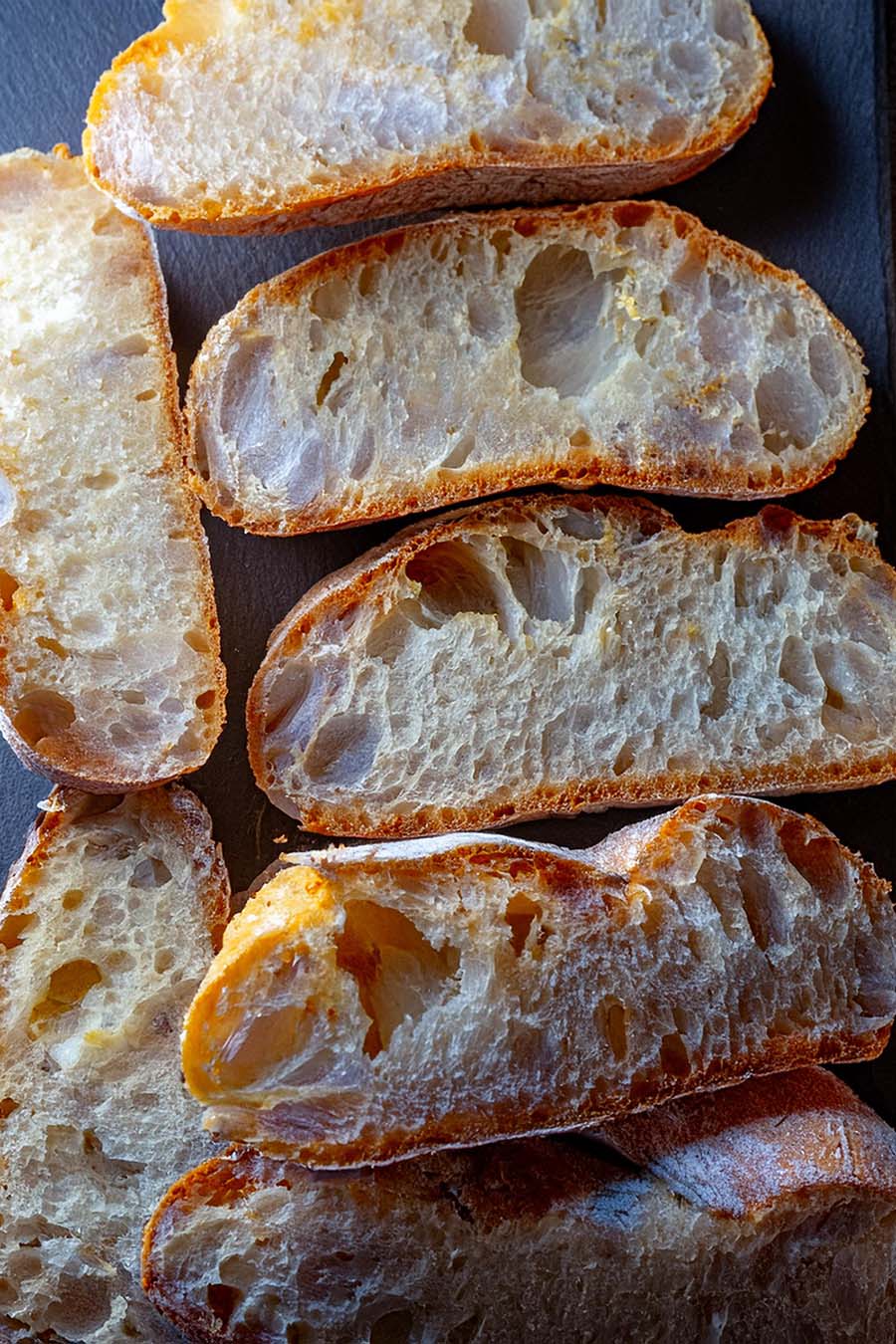
Ingredients You’ll Need:
- Unbleached Bread Flour
- Salt
- Instant Yeast
- Chilled Water
- Olive Oil
Equipment You’ll Need:
- Mixing Bowl: Large enough to allow the dough to expand during fermentation.
- Stand Mixer (Optional): Useful for initial mixing, but not required.
- Bowl Scraper or Spatula: Helps handle the sticky dough with minimal mess.
- Pastry Scraper: For shaping the dough without deflating it.
- Baking Stone or Sheet Pan: A baking stone produces a crisper crust, but a sheet pan works as well.
- Parchment Paper: Prevents sticking and makes transferring the dough easier.
- Oven-Safe Shallow Pan: Creates steam, which is crucial for achieving a crisp crust.
Important Cooking Tips:
- Expect a Sticky Dough: Ciabatta dough has high hydration and will feel wet—resist the urge to add extra flour.
- Use Wet Hands: To prevent sticking while handling the dough, dampen your hands before stretching and folding.
- Let the Dough Rest Properly: Resting periods allow gluten to develop naturally, improving texture and structure.
- Don’t Overwork the Dough: Handling it too much will deflate the air pockets, leading to a denser loaf.
- Steam for a Crisp Crust: Pouring hot water into a pan in the oven helps create a crisp, crackly exterior.
Planning Ahead:
- Refrigerate the Dough for Better Flavor: While an overnight rest is ideal, you can refrigerate the dough for up to four days for a deeper, more complex taste.
- Prepare Steam Setup in Advance: Having your baking stone and steam pan preheated ensures the best oven conditions for baking.
- Shaping Takes Practice: Handle the dough gently when forming the loaf to maintain its airy texture.
Storing, Freezing, Reheating:
- Room Temperature: Store in a paper bag or bread box for up to 2 days. Avoid plastic bags, which soften the crust.
- Freezing: Wrap in plastic wrap and freeze for up to 3 months. Thaw at room temperature before reheating.
- Reheating: To restore crispness, warm in a 375°F (190°C) oven for 5-10 minutes.
FAQ:
Q: Why is my ciabatta dough so wet and sticky?
A: High hydration is key to ciabatta’s airy texture. Use a scraper or wet hands to handle the dough instead of adding extra flour.
Q: How can I make ciabatta without a baking stone?
A: A preheated sheet pan works as an alternative. The key is to bake with steam for a crisp crust.
Q: My ciabatta didn’t rise much—what went wrong?
A: Make sure your yeast is fresh, and allow the dough to ferment long enough at room temperature before refrigerating.
Q: Can I make ciabatta with all-purpose flour?
A: Yes, but bread flour is recommended for its higher protein content, which helps create the open crumb structure.
Q: How do I know when my ciabatta is done baking?
A: Tap the bottom—if it sounds hollow, it’s done! The crust should be deep golden brown.
Substitutions and Allergies:
- Gluten-Free Alternative: A high-hydration gluten-free flour blend is required, but results will vary.
- Oil-Free Version: Omit olive oil; the bread will still develop a good texture but may be slightly chewier.
- Whole Wheat Variation: Substitute up to 30% whole wheat flour for a nuttier, denser ciabatta.
Beverage Pairings:
- Chianti or Sangiovese: A bold Italian red wine that complements the rustic flavor.
- Espresso or Cappuccino: Classic pairings, perfect for an Italian-style breakfast with ciabatta and jam.
Step-by-Step Guide to Making Ciabatta at Home
Step 1: Prepare the Dough
- In a large mixing bowl, combine the bread flour, salt, yeast, and water.
- If using a stand mixer, mix on low speed with the paddle attachment for 1 minute. If mixing by hand, use a large spoon and stir until just combined. The dough will be very sticky and wet.
- Let the dough rest for 5 minutes to allow the flour to fully absorb the water.
Step 2: Strengthen the Dough
- Drizzle the olive oil over the dough and mix again for about 1 minute on medium-low speed (or stir with a wet spoon if mixing by hand). The dough should become slightly smoother but remain soft and sticky.
- Transfer the dough to a lightly oiled bowl using a wet spatula or bowl scraper. Cover with plastic wrap and let rest for 10 minutes.
Step 3: Stretch and Fold the Dough
- Lightly oil a work surface and place the dough onto it.
- Using wet or oiled hands, gently stretch the front end of the dough outward and fold it back over the center. Repeat this process from the back and both sides.
- Flip the dough over and form it into a soft ball.
- Place it back in the bowl, cover, and let sit for 10 minutes.
- Repeat this stretch-and-fold process three more times at 10-minute intervals.
Step 4: Overnight Fermentation
- Cover the bowl tightly and refrigerate overnight, or for up to 4 days.
- The dough will rise significantly in the fridge, developing flavor and texture.
Step 5: Preparing for Baking
- Remove the dough from the refrigerator 3 hours before baking to allow it to reach room temperature.
- After about 1 hour, line a baking sheet with parchment paper and dust it generously with flour.
- Transfer the dough gently onto a floured work surface, avoiding deflating it.
- Using a pastry scraper or hands, gently shape the dough into a rough 9-inch square while handling it as little as possible.
Step 6: Preheat the Oven
- 45 minutes before baking, preheat the oven to 550°F (288°C) or as high as it will go.
- If using a baking stone, place it inside the oven to heat up.
- Prepare a shallow pan for steaming by placing it in the bottom rack of the oven.
Step 7: Baking the Ciabatta
- Slide the parchment paper and dough onto the hot baking stone (or place the baking sheet directly into the oven).
- Pour 1 cup of hot water into the steam pan below to create steam.
- Lower the oven temperature to 450°F (232°C) and bake for 12 minutes.
- Rotate the bread and continue baking for 15-20 minutes, or until the crust is deeply golden brown.
- Remove from the oven and let cool on a wire rack before slicing.
Love Baking? Check Out These Wonderful Recipes:
Rieska – Finnish Potato Flatbread
How to Make Pita Bread at Home
Jalapeño-Cheddar Sourdough Bread
Cinnamon-Sugar Churro Banana Bread
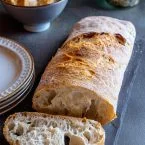
How to Make Ciabatta Bread: Authentic Italian Recipe
- Total Time: 60 mins plus overnight fermentation
- Yield: 1 large or 2 smaller loaves 1x
Description
Originating in the 1980s as an Italian response to French baguettes, this rustic loaf is perfect for sandwiches, dipping in olive oil, or enjoying on its own.
Ingredients
4 1/2 cups (540g) unbleached bread flour
1 3/4 teaspoons salt
1 1/4 teaspoons instant yeast
2 cups (475ml) chilled water (about 55°F or 13°C)
1 tablespoon olive oil
Instructions
Step 1: Prepare the Dough
- In a large mixing bowl, combine the bread flour, salt, yeast, and water.
- If using a stand mixer, mix on low speed with the paddle attachment for 1 minute. If mixing by hand, use a large spoon and stir until just combined. The dough will be very sticky and wet.
- Let the dough rest for 5 minutes to allow the flour to fully absorb the water.
Step 2: Strengthen the Dough
- Drizzle the olive oil over the dough and mix again for about 1 minute on medium-low speed (or stir with a wet spoon if mixing by hand). The dough should become slightly smoother but remain soft and sticky.
- Transfer the dough to a lightly oiled bowl using a wet spatula or bowl scraper. Cover with plastic wrap and let rest for 10 minutes.
Step 3: Stretch and Fold the Dough
- Lightly oil a work surface and place the dough onto it.
- Using wet or oiled hands, gently stretch the front end of the dough outward and fold it back over the center. Repeat this process from the back and both sides.
- Flip the dough over and form it into a soft ball.
- Place it back in the bowl, cover, and let sit for 10 minutes.
- Repeat this stretch-and-fold process three more times at 10-minute intervals.
Step 4: Overnight Fermentation
- Cover the bowl tightly and refrigerate overnight, or for up to 4 days.
- The dough will rise significantly in the fridge, developing flavor and texture.
Step 5: Preparing for Baking
- Remove the dough from the refrigerator 3 hours before baking to allow it to reach room temperature.
- After about 1 hour, line a baking sheet with parchment paper and dust it generously with flour.
- Transfer the dough gently onto a floured work surface, avoiding deflating it.
- Using a pastry scraper or hands, gently shape the dough into a rough 9-inch square while handling it as little as possible.
Step 6: Preheat the Oven
- 45 minutes before baking, preheat the oven to 550°F (288°C) or as high as it will go.
- If using a baking stone, place it inside the oven to heat up.
- Prepare a shallow pan for steaming by placing it in the bottom rack of the oven.
Step 7: Baking the Ciabatta
- Slide the parchment paper and dough onto the hot baking stone (or place the baking sheet directly into the oven).
- Pour 1 cup of hot water into the steam pan below to create steam.
- Lower the oven temperature to 450°F (232°C) and bake for 12 minutes.
- Rotate the bread and continue baking for 15-20 minutes, or until the crust is deeply golden brown.
- Remove from the oven and let cool on a wire rack before slicing.
Notes
Flour Choice: Bread flour is recommended for its higher protein content, which improves the structure of the ciabatta.
Hydration: The dough is very wet—this is normal. Avoid adding more flour as it affects the texture.
Shaping: Handle the dough gently to preserve the airy texture.
Steam for Crust: Using a pan of water in the oven creates the signature crisp crust.
Long Fermentation: Refrigerating overnight enhances the flavor and allows flexibility in baking time.
- Prep Time: 30 mins
- Fermentation Time: Overnight
- Cook Time: 30 mins
- Category: Bread
- Method: Baking
- Cuisine: Italian
Nutrition
- Serving Size: 1 slice
- Calories: 180
- Sugar: 1g
- Sodium: 290mg
- Fat: 2g
- Saturated Fat: 0.5g
- Unsaturated Fat: 1g
- Trans Fat: 0g
- Carbohydrates: 35g
- Fiber: 3g
- Protein: 6g
- Cholesterol: 0g











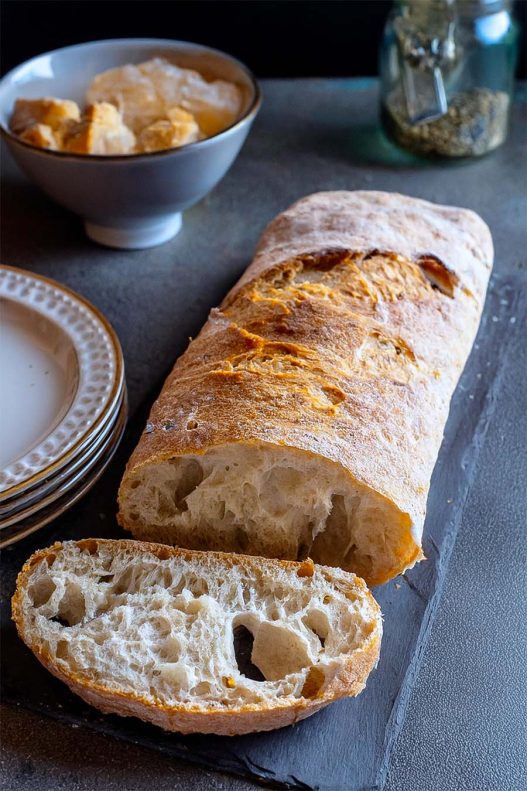
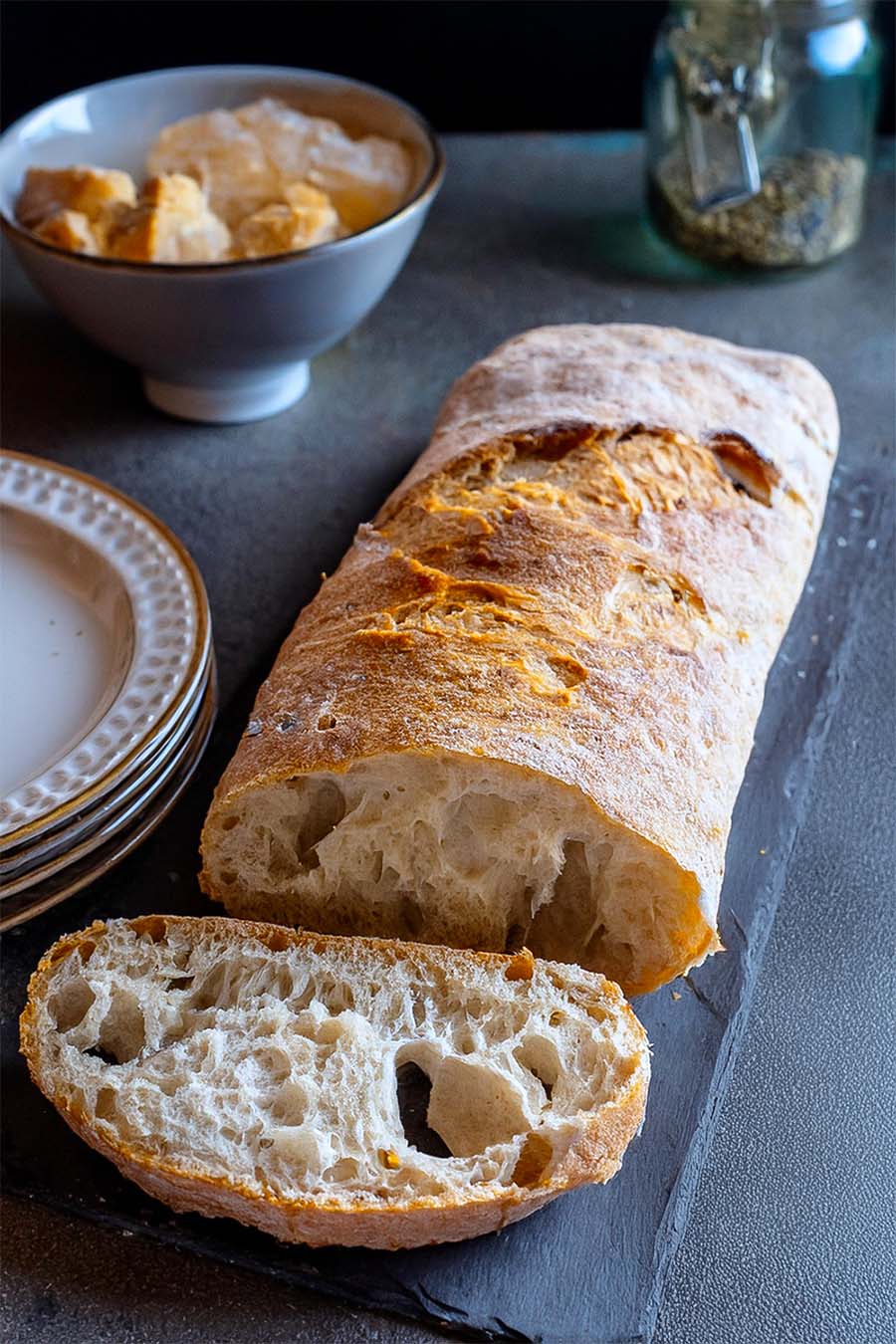
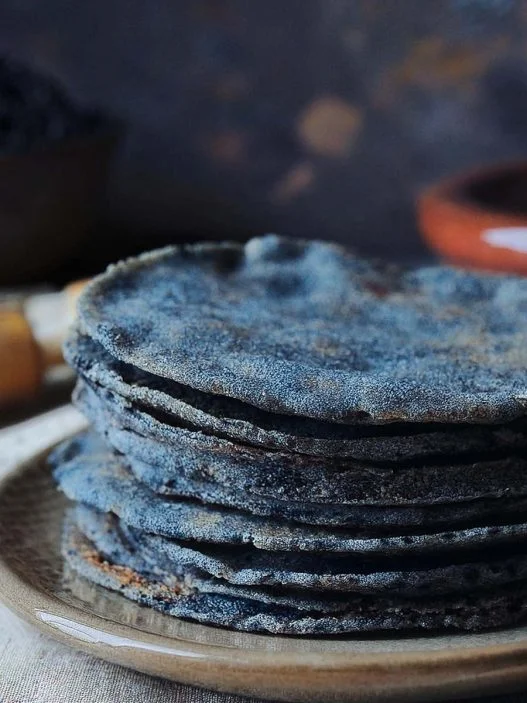










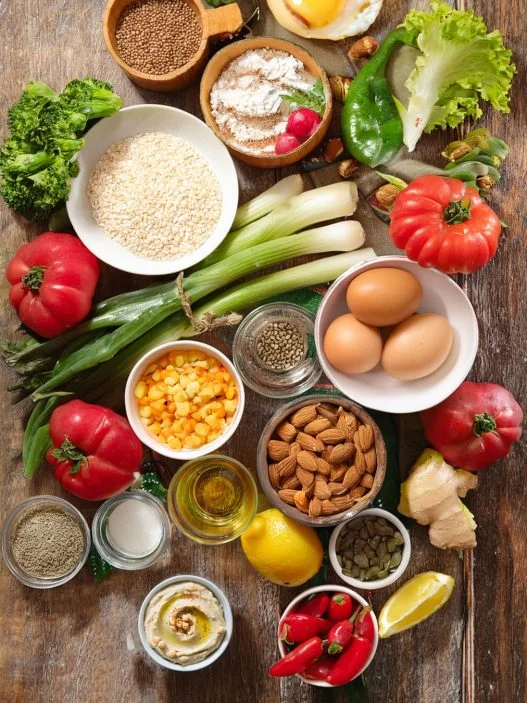
I had never tried ciabatta before, the many steps made me a little nervous but honestly it was very easy and the bread turned out gorgeous. So much fun!!
Huge ciabatta fan here, this is a great recipe. Came out with the exact right crunch of the crust, and a lovely interior.
I let mine ferment for two days, and the flavor was amazing!
Bread came out perfectly, I used bread flour and it was just great. Thanks!
This was surprisingly easy actually, so glad I tried it. Will make again!
My favorite ciabatta recipe of all times!
Ciabatta is one of my favorite breads! But never made it at home – I was wondering if it would work with all purpose flour?
Hi Kulsum. Yes, I used all purpose flour and it worked out just fine!
This ciabatta looks great and tasted just perfectly. Thank you for a great recipe!
Thank you Tamara!
Your Ciabatta turned out lovely. To me there is nothing like homemade bread.
I agree! About the homemade bread and there being nothing like it… especially brioche!